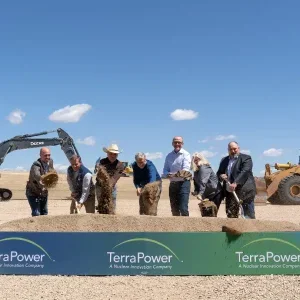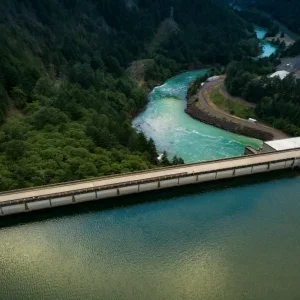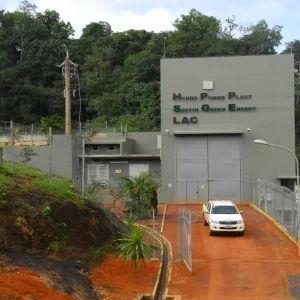Over the years, hydro power has helped shape the landscape of northwest England, UK, but it is now widely viewed as a resource with limited opportunity. In the past it determined the location of industry and provided reliable power to carry out a range of tasks. However, since the end of the 19th century its importance in the country has declined. But the resource that supported the UK’s Industrial Revolution is still contained within the landscape and can still be harnessed to its advantage. With current calls for diverse clean supplies of energy, all resources should be examined and exploited wherever economically possible. By identifying the potential capacity and defining methods of exploitation, it is possible to circumvent the barriers to development. Northwest England has both suitable drainage systems and consistent demand making hydro, and more especially low-head hydro, an attractive proposition.
There is no single barrier to the utilisation of small hydro power, but instead several obstacles which together impede development. Indeed, the northwest of England currently generates a limited amount of hydro power (14 sites generating 8.2GWh and with an installed capacity of 4.3MW, according to 2004 regional statistical figures) and occasionally new sites are investigated, both by utilities or private investors. The obstacles can be thought of as a series of questions that would be posed when deciding whether to develop systems or not. These questions require expertise from a number of disciplines to answer with sufficient confidence and their responses have to be integrated through an economic evaluation to produce a decision.
There are a number of potential users of a resource model who will each benefit from the model despite their different perspectives. These range from the Environment Agency (EA) which, as a regulator, controls the issue of licences for abstraction, is responsible for the chemical and biological condition and quality of the water, but is also mandated to encourage use of clean renewable power as mitigation for climate change. Large organisations such as United Utilities and Hyder may see the opportunity to exploit market potential, using the tool to target opportunities. At the smaller scale, a number of organisations in the northwest are keen to be involved in the expansion of a new system; these include manufacturers, engineers and consultants.
Project goals
This project will address research issues across a number of disciplines that intend to form a framework which other projects can use as a model to investigate new turbine designs, the impacts of climate change on northwest England hydrology, standardised environmental impact assessment and the dynamics of public attitudes.
The project will describe the development of a system to promote the exploitation of hydro power in northwest England. The system is composed of a series of integrated models addressing the barriers to installation of devices as seen through different disciplines. The information is linked through an economic assessment which identifies different turbine options, assesses their suitability for location and demand and combines the different styles of information in a way that supports decision making.
The system is structured into five components. The hydrological resource is modelled using Low Flows 2000 and is being extended to improve coverage of smaller ungauged rivers, the turbine options will be identified from hydrological, environmental and demand requirements and the consequences of the different solutions will be fed into the other components so that the environmental impacts and public acceptability can be assessed and valued. The system will also feed information into the hydrological resource estimates so that the consequences of multiple installations can be assessed.
The modelling approaches being employed will differ within each component, using mathematical, statistical and cost-benefit approaches. The outputs will be presented in a range of formats enabling use of the results to be made by different users. The model is seen as a tactical tool that will operate at the level of individual low and ultra-low head hydro installations and there is interest from potential users across a range of scales from large utilities and national agencies to local manufacturers.
The development of the model will include field validation of any forecast figures and will identify the necessary monitoring and gauging to identify measures that can be taken to confirm the confidence in the proposed solution. It is intended that the system, once initiated, could be developed further for use outside the northwest of England.
Overcoming problems
The information involved in the decision process for installation of a hydro system is illustrated in the image opposite.
Each component requires expertise from an individual discipline, often with input from several different disciplines. The individual components are described below.
Demand & economics
The contribution from economics will address essentially two issues. The first relates to the narrowly identified costs and revenues associated with different turbine technologies, both existing and nascent. The second relates to the wider environmental aspects of the programme, in particular the costs and benefits to the community e.g. loss of amenity, degradation of the physical environment etc.
In order to address these questions, a model will be developed for the project that captures the micro-economic aspects of the process of transforming inputs into outputs. Development of this model will take into account both demand and supply considerations. More specifically it will identify the factors that determine demand for generating output, and the output that can be generated under different technological conditions.
This will enable the operator to compare different systems in terms of their profitability. More generally, data from the other sections of the project will be used, along with publicly available data to address the environmental issues that arise from the use of the different technologies. The information derived within this section will be formulated so as to support decision making.
Resource capacity
Within the UK there are over 250,000 river reaches mapped at a scale of 1:50,000. By contrast, there are approximately 1600 permanent gauging stations and thus the majority of catchments are ungauged. The northwest is typical of the UK in that there are gauging stations on each of its major rivers that enable flow duration curves to be developed but the majority of smaller river systems are ungauged. However, it is within these smaller catchments that the majority of opportunities for low head and small hydro power exist.
To address this need, the Centre for Ecology and Hydrology has developed software systems for estimating hydro power generation potential (the HydrA package) based upon estimates of the flow duration curve for ungauged catchments (the Low Flows 2000 system). Low Flows 2000 is the standard system used by the EA for generating estimates of river flows within ungauged catchments and incorporating the impacts of water use (reservoirs, abstractions and discharges) upon these natural estimates of river flow. While Low Flows 2000 estimates provide a good basis for identifying potential hydro power sites, for detailed design and estimation of environmental consequence there remain a number of research issues that currently constrain development opportunities:
• The uncertainty in the prediction of flow duration curves needs to be constrained to minimise the uncertainty in energy production to demonstrate the viability of a scheme. The author thinks that currently this is undertaken in an unsatisfactory manner. The challenge is to identify how short record flow data (down to individual flow measurements) can be used to constrain the uncertainty in the prediction of flow duration statistics within ungauged catchments in northwest England, and to determine how this hydrological uncertainty propagates through to an uncertainty in the estimation of energy production.
• Current scheme viability is defined on long-term estimates of flow regimes. A more pertinent question is what will be the likely evolution of energy generation over the period of capital borrowing and payback, and whether this can be estimated within ungauged catchments.
• In pursuit of generation capacity, scheme promoters are looking at the utilisation of higher flows. However the question remains of how robust designs are to the impact of high flows (and in some locations high flow-induced sediment transport).
• Finally, for larger schemes the potential impact of catchments and climate change on energy generation (though the latter might not be significant over the design lifetime of a scheme) needs to be answered. This is currently ignored within current design practices.
Engineering options
Accepting that economic benefit is the driver for installation, what is needed is a scoping of the turbine options for different resource, environment and demand at any specific location. A model will be developed that will take data generated by other components of the system, namely hydrology (e.g. water levels, heads, flow duration curve), demand (e.g. household size) and characteristics of physical environment (e.g. geology, bed stability) and devise parameters to filter different designs for their suitability. Each design will have its own specific characteristics and major components including storage, culvert, penstock, power station and tailrace system whose values will be adjusted for each location.
The options will be passed on to other sections of the overall system so that they can be assessed for their environmental implications, public acceptability and overall economic cost. Data will also be supplied to the resource capacity section so that any impact on the hydrological resource can be relayed for inclusion in future estimates.
Once a decision has been proposed, and one of the turbine designs has been selected, the situation will be reassessed and the specification for the installation will be worked out in detail. Characteristics of size, construction and reliability will be derived and detailed costing for optional modification of the design assessed. One of the big areas of uncertainty will be the full economic cost of the plant and its installation. Financing charges, the cost of connection to the grid, access to the site, maintenance costs, decommissioning and site remediation all need to be included, in addition to the cost of the rotating plant. The exploitation mode will influence the development and options for different strategies will be included. For example the electrical connection may be isolated from the grid, linked directly to the grid or passed through a household supply (considering safety issues connected with feeding a supply back into a house wiring system) and only pass to the grid when the demand is satisfied. Additional characteristics will be considered so that full life cycle analysis of the device can be calculated.
Environmental implications
The environment is often seen as a major stumbling-block, with the need for an Environment Statement (under Town & Country Planning Regulations – Assessment of Environmental Effects). The author thinks the requirements for environmental protection with regard to hydro schemes are ill-defined, and need to reviewed and re-formulated. The ‘ad hoc’ approaches to defining the impacts of hydro schemes on the in-stream requirements of aquatic flora and fauna are often cited by developers as the most significant barrier to the successful promotion of schemes, and need to be revised with a framework developed. There are a number of tools in use for this, such as the River Habitat Survey (UK Environment Agency, 2003), RIVPACS (Centre for Ecology and Hydrology) and Mean Trophic Ranking (Centre for Ecology and Hydrology) which can be applied to measure the current environmental state. These cover both the physical environment, through the River Habitat Survey, and the biological environment, through RIVPACS and Mean Trophic Ranking. The Water Framework Directive requires that water bodies be maintained in, or improved to, good status. Good status includes chemical, biological and physical components and it is therefore unlikely that a large number of undeveloped sites would be considered by the EA for low-head hydroelectric installations.
Outputs from the environmental component are needed to identify the effect the environment has upon the physical components of the turbine installation. High sediment loads, eutrophic waters, or highly acidic waters may reduce the life of the turbine or increase the required maintenance. This would reduce the economic efficiency of the turbine, possibly below the level acceptable for installing the turbine in the first place. It is important that these environmental factors be considered throughout the decision making process and monitoring of stream characteristics will be performed prior to, during and post installation.
Public engagement
How the public engage with hydro technology is a crucial question for implementation in practice. Members of the public are:
• Potential adopters of the technology at a micro household level.
• Potential participants in collective community processes for the adoption of technology at a micro level (for example for community buildings or groups of households).
• Potential neighbours of technology installations at micro or meso levels who may in some circumstances be concerned about the local impacts of the installation (visual, ecological, noise etc).
Comparatively little is known about how members of the public might view hydro technologies, either in the general abstract or in specific contexts. It is therefore crucial to develop these understandings, to try and identify key factors which shape perceptions and potential patterns of adoption or resistance, and to develop processes of engagement (which might include various forms of communication, participation, facilitation of collective action etc.) that are appropriate for different technologies, scales and contexts of installation. In this respect it will be important to recognise the diversity of both the public and of stakeholder groups who may have an interest in the installation and impacts of low head hydro technologies (such as fisheries groups, landowners, tourism industry, conservation groups, local councils).
Possible benefits
The northwest of England could benefit in a number of ways from the results of this project:
• The project could lead to improved utilisation of the renewable resources available to the northwest of England and offer an increased diversity of supply of power that will help meet national government targets.
• Any increased use of hydro power will offer economic benefits to the northwest of England through increased jobs (in manufacture, installation and maintenance).
• Individuals and local communities can benefit from the utilisation of small scale hydro as the systems will be in their ownerships. This will include farmers who are still recovering from the pressures of BSE and foot and mouth, diseases that hit the UK’s agriculture industry in recent years.
• The local generation of power also alters attitudes to efficiency and waste and can benefit the northwest of England in general.
• Once the system has been developed, it can be marketed beyond the northwest as a form of technology transfer.
Objectives and further plans
Every day we face the threat of climate change and global warming: from global temperature increase, increasing severity and changing patterns of irregular storms and earthquakes, to the greater frequency of droughts in many parts of the world. Indeed, Prof Sir David King, the Chief Scientist of the UK government, said when challenging the Bush administration to take climate change more seriously: ‘Climate change is the most severe problem we are facing today, more serious even than the threat of terrorism’.
The UK government is, however, taking steps that demonstrate its concern for the environment. In 2001, it formally signed up to the Kyoto Protocol; it is thus legally bound to reduce greenhouse gas emissions to 12.5% below 1990 levels by 2008-2012, to 20% by 2020 and potentially 60% carbon emissions cuts by 2050.
The UK Energy Review Report, published in July 2006, reassesses national policy on energy and reinforces the government’s call for research into diverse sources of power. Hydro and indeed its micro-generation aspect is an area offering a relatively untapped resource available throughout the northwest of England. One large benefit of individuals being more closely involved with meeting their own energy requirements is that their view of energy use changes and they tend to become more aware and thus more conservative, contributing further to the overall demand reduction effort towards achieving the targets on greenhouse gas emissions.
In conclusion the objectives and future plans for this project are to:
• Develop a generic and fundamental understanding of the barriers to deployment of hydro systems in the northwest.
• Integrate the different disciplines involved so that their information needs are met and conclusions can feed into the decision process in combination with other disciplines.
• Benchmark the output of the model and compare with actual decisions.
• Design the model as a functional tool so that its output is timely and valued by users.
• Develop forms of output in consultation with users so that they are relevant to their needs.
The approach will identify the advantages of different solutions, not only in financial terms but also through environmental, cultural and wider economics.
Author Info:
George A. Aggidis, Director, Lancaster University Renewable Energy Group, Department of Engineering, Faculty of Science and Technology, Lancaster University, Bailrigg, Lancaster, LA1 4YR, England.
The author wishes to express his appreciation of the support of the Joule Centre for Energy for the research reported in this article through the Joule Grant Ref JIRP106/07.






